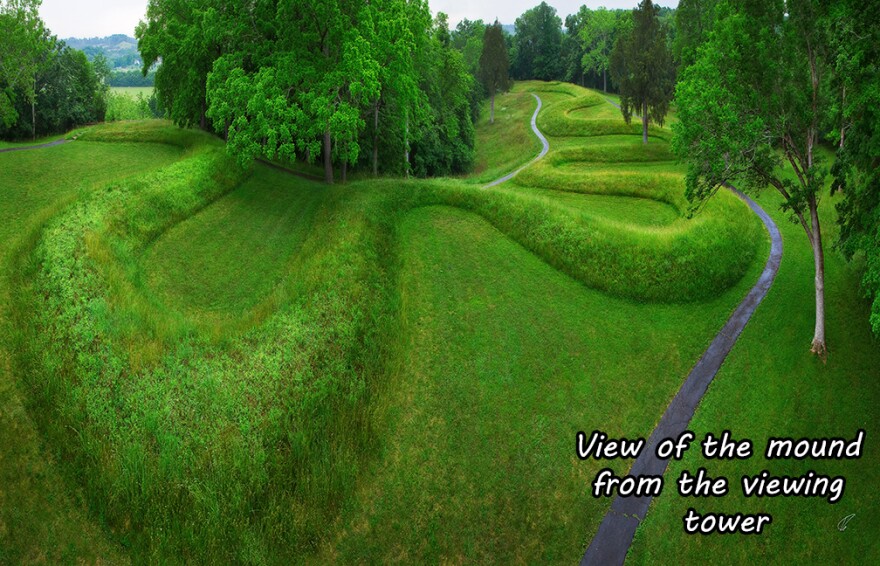A group that supports the Serpent Mound historical site in Adams County is upset with the decision to cancel a popular Winter Solstice event.
Ohio History Connection (OHC), which owns the National Historic Landmark, permanently canceled "Lighting the Serpent" last month citing the event's inauthenticity.
President Jeff Wilson says Friends of Serpent Mound accepts the decision, but they aren't happy about it or the process by which it was reached.
"They did not reach out to us to discuss it with us before contacting us and just handing us a decision," he says. "They didn't say 'We don't really like this' or 'We want to change this' or 'We think you should make some changes.' It was just 'It's over. It's canceled.'"
Friends of Serpent Mound began lighting the ancient earthwork in 2004 with luminarias on each Dec. 21. The goal, they say, was to show how the snake-shaped mound was designed to align with the rising and setting of the sun on the Winter Solstice.
"We borrowed a little bit from Christmas tradition, the luminary candles, and decided to line the entire length of Serpent Mound with about a thousand luminary candles and it became a magical tradition," says Wilson. "It was an amazing experience for those who have come out there and seen it."
The problem, according to the OHC, is the event has nothing to do with the mound's origins or the people who built it thousands of years ago.
"We have a responsibility to tell a story that's accurate, particularly that's representative of American Indian heritage," says Ohio History Connection CEO Burt Logan.
Logan admits no Native American groups complained about the event, a point the Friends group says makes the OHC's explanation vague. However, he says the decision was reached after conversations with leaders of multiple tribal nations with Ohio ties.
"We believe that once we understand what is the right thing to do, to continue doing something else is not being a very respectful steward. It's not being authentic. We want to tell the story of Serpent Mound that is most authentic to the American Indian heritage of the site."

Serpent Mound's origins remain somewhat of a mystery. Carbon dating shows it was likely two different cultures, the Adena, sometime around 325 BC and the Fort Ancient, around 1070 AD.
Wilson says that's an argument in favor of continuing Lighting the Serpent.
"Cultures have arisen and lived full lives and disappeared - several cultures - over the course of several thousand years, and every one of those ancient cultures used Serpent Mound for their own cultural purposes in their own time," he says. "To pick any one tribe's religious tradition to enforce whatever their particular beliefs are upon this site, I think is a bit of a historic fraud."
Glenna J. Wallace is chief of the Eastern Shawnee Tribe of Oklahoma. She's done a lot of work on mounds in general, as well as Serpent Mound.
"Mounds are sacred sites to us," she says. "Sacred sites means that there's an expected level of protocol, an expected level of behavior that goes with that and an appropriate level of activities that goes along with that."
Wallace concedes the event likely began as something beautiful and respectful. "But behaviors have been permitted to come along with that that, in my opinion, have diminished that respect to the point that it now becomes more a matter of curiosity, an expectation of partying. That, to me, is not consistent with the sacred expectations of such a site."
She specifically points to behaviors she calls disrespectful such as drug use at the site, "New Age crystals," and various acts of vandalism at the mound.
Wallace says she's been to Serpent Mound for several Lighting the Serpent events.
"Hundreds of years ago they did not do the luminaries," she says. "I'm not saying we succeed all the time, but we try to teach our young people and people who visit what is acceptable protocol and how we have reverence for these sites, and we expect others to respect our beliefs that date back well beyond [when the lighting started]."
Serpent Mound (the park only, not the visitor's center) will be open until sunset on Dec. 21 so visitors can still experience the solstice alignment. Friends of Serpent Mound is hosting a reception and lecture that evening at Braten Township Hall in Peebles.
If You Were Wondering
Is it "luminary" or "luminaria?"
According to City Editor Tom Jones in this 2014 Times-News article, "The correct, but wrong, term is 'luminaria,' not 'luminary,' and two or more such lanterns are correctly, but wrongly, called 'luminarias.'"
He continues, "But they're not 'luminarias,' much less 'luminaries.' They're 'farolitos,' Spanish for 'little lantern.' 'Luminaria,' meanwhile, translates as 'festival light' and refers to a bonfire. And 'luminaries' is even further removed from the correct term."
The tradition comes from Mexico and involves filling a paper bag with a few cups of sand and a votive candle.
Visit Albuquerque claims luminarias "when the Spanish villages along the Rio Grande displayed the unique and easy to make Christmas lanterns, called luminarias to welcome the Christ child into the world."



